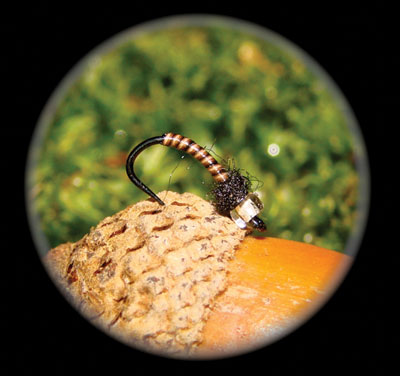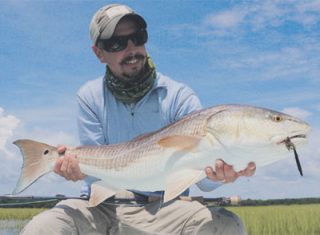By: Dustin Stanberry

The Mirror Midge is a pattern that is based off a lot of the simple midge patterns you see today. The use of stripped peacock herl is nothing new in the way of design. It offers the body of the fly a great appearance of segmentation without building a lot of bulk and throwing the proportions of the fly off.
After studying midge larva a bit and through trial and error the Mirror Midge was born. The use of the Tiemco 206BL hook was one of the changes that I made to better represent swimming midge larva. The shape and color of the hook allow the hook to become part of the body of the fly. The difference the hook color makes in the fishes eye may be minimal to null but, if the fish are already looking at flies in the size 20-22 ranges, perhaps the subdued hook coating will help.
The other item that helps this fly better represent a midge larva is the clear glass bead. As larva mature and begin to hatch they create a gas bubble in the larval shuck and ride it to the surface. The diamond glass bead gives the fish something to key in on that is more representative of the gas bubble generated in the natural midge larva. The glass bead gives the fly a subtle bit of flash and adds a little weight to help things get down. It’s a great fly to use as a dropper behind and adult midge or Griffith’s Gnat during a midge hatch.
Additionally, placing two short strands of Krystal Flash behind the thorax extended toward the rear of the fly can act as wing buds on a hatching midge. Of course the colors of material used can be changed to match the midge larva where you are fishing. I like to tie them in green and red as well using died peacock herl.
Hook: Tiemco TMC 206BL, #16-20
Thread: Giorgio Benecchi’s 12/0, Black
Bead: Killer Caddis Glass Bead, Midge size in Diamond
Body: Stripped Peacock Herl
Thorax: Black Superfine DubbingOptional info: I like to place a little brush on super glue on the hook shank before I wrap the body forward. This will help the durability of the fly.
I think you will find this pattern helpful as the temps cool down and we head into winter. Best wishes and tight lines!
Dustin Stanberry is an instructor at Biltmore Fly Fishing and Sporting Clays school located in Asheville, NC.

